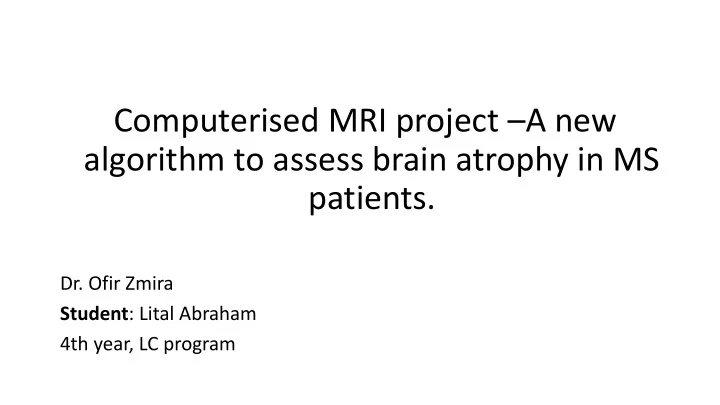

Computerised MRI project – A new algorithm to assess brain atrophy in MS patients. Dr. Ofir Zmira Student : Lital Abraham 4th year, LC program
Definition of MS An immune-mediated inflammatory disease that attacks myelinated axons in the central nervous system (CNS), destroying the myelin and the axon in variable degrees. In most cases, the disease follows a relapsing-remitting pattern, with short-term episodes of neurologic deficits that resolve completely or almost completely. A minority of patients experience steadily progressive neurologic deterioration.
MRI IS THE ONLY WINDOW WE CAN USE TO LOOK DIRECTLY AT PATOLOGICAL PROCESSESS OF THE BRAIN.
Diagnostic criteria for MS
Clinico-radiological Paradox
• Brain atrophy in multiple sclerosis (MS) was classically thought of as a late-stage phenomenon. • Over the past two decades, understanding of brain atrophy in MS has been substantially revised . It is now clear that atrophy begins very early in the disease can progress relatively independently of overt lesions (Fisniku et al., 2008), affects both gray matter (GM) and WM, and proceeds at up to 5 times the rate associated with normal aging (Miller et al., 2002).
• Quantitative measurements of atrophy have been shown to be the best correlates and long- term predictors of both cognitive and clinical disability (Benedict et al., 2006; De Stefano et al., 2014; Summers et al., 2008; Zivadinov et al., 2016b). • This revised understanding of the importance and clinical relevance of brain atrophy in MS encouraged the emergence of quantitative image-based computational techniques for measuring brain atrophy more precisely and accurately than is possible by eye. • There is a need for a brain volume measure applicable to the clinical routine scans. Nearly every multiple sclerosis (MS) protocol includes low-resolution 2D T2-FLAIR imaging
Need to gather patients and divide them to groups by different parameters such as disease course, treatment and etc…. Collect data all over the world and create an universal Atlas
NeuroSTREAM p proje ject Background: There is a need for a brain volume measure applicable to the clinical routine scans. Nearly everymultiple sclerosis (MS) protocol includes low-resolution 2D T2-FLAIR imaging. Aim: To develop and validate cross-sectional and longitudinal brain atrophy measures on clinical-quality T2- FLAIR images in MS patients Methods: A real-world dataset from 109 MS patients from 62 MRI scanners was used to develop a lateral ventricular volume (LVV) algorithm with a longitudinal Jacobian-based extension, called NeuroSTREAM. Measurement at different field strengths was tested in 76 healthy controls and 125 MS patients who obtained both 1.5T and 3T scans in 72 hours. Clinical validation of algorithm was performed in 176 MS patients who obtained serial yearly MRI 1.5T scans for 10 years. Results: NeuroSTREAM showed comparable effect size(d =0.39 – 0.71) in separating MS patients with and without confirmed disability progression, compared toSIENA and VIENA. Conclusions: Brain atrophy measurement on clinical quality T2-FLAIR scans is feasible, accurate, reliable, and relates to clinical outcomes.
Recommend
More recommend